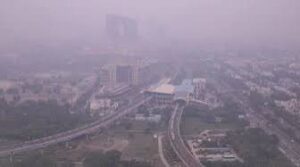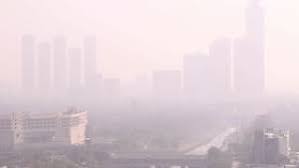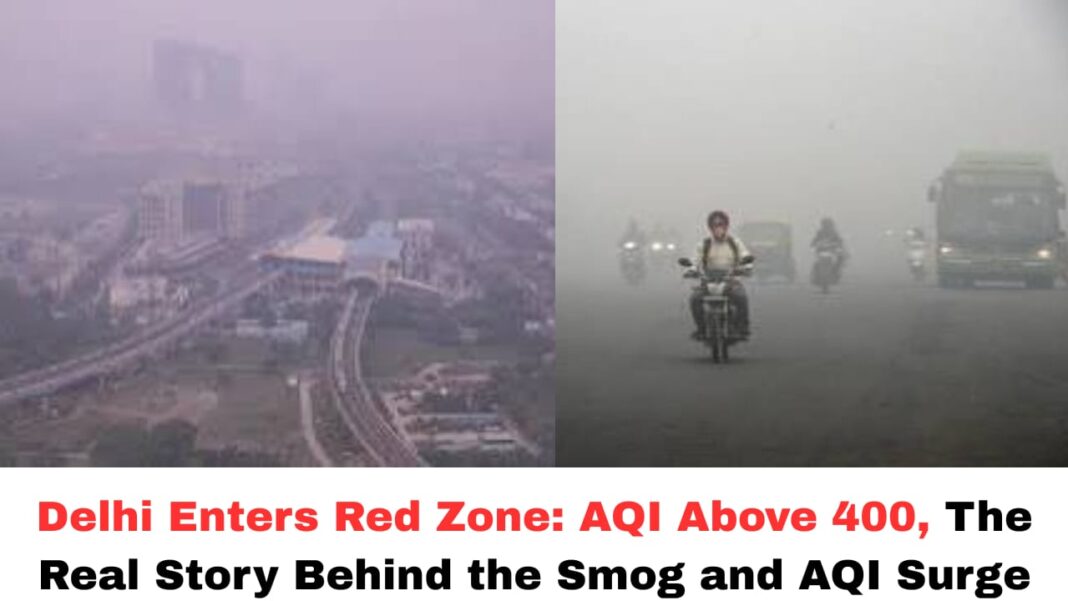Digital News Guru New Delhi Desk:
Delhi’s Air Quality Plunges into “Severe” Zone
Key Facts
- The capital city’s 24-hour average Air Quality Index (AQI) reached 361 as of the afternoon of 8 November 2025, placing Delhi in the “red zone”.
- Some areas recorded readings above 400, meaning they were in the “severe” pollution category. For example: Wazirpur (420), Burari (418), Vivek Vihar (411).
- In nearby NCR regions — Noida, Greater Noida and Ghaziabad — AQI levels also worsened: 354, 336 and 339 respectively.

What’s Driving the Spike?
- Seasonal factors: With winter approaching, cooler, stagnant air traps pollutants close to the ground, worsening smog.
- Crop-residue burning in neighbouring states contributes significantly to the particulate load. Combined with dust from construction and ongoing vehicular emissions.
- Local emissions: traffic, industrial activity, road dust and open burning add up.
Why It Matters
- Health Risks: At “severe” pollution levels, residents can suffer throat irritation, worsening of asthma and other respiratory/cardiac conditions. Hospitals in the city report rising patient numbers.
- Visibility & daily life: Smog affects visibility, outdoor activity, sports, school sessions, and can lead to reduced productivity and general discomfort.
- Policy implications: The air-quality crisis puts pressure on authorities to enforce stricter control measures, including measures under the Graded Response Action Plan (GRAP). Yet, despite the high levels, the city has not yet triggered GRAP Stage 3.
Status of Control Measures
Despite the alarming levels, the Delhi government and regulatory bodies say that GRAP Stage 3 restrictions have not yet been enforced, because they believe the overall monthly pollution is still better than last year at this time.
This means that some of the harsher restrictions (such as closure of schools, ban on heavy vehicles, widespread stop of construction) are still under consideration but not activated yet.

What Should Residents Do?
Here are practical steps for residents of Delhi/NCR given the current situation:
- Limit outdoor exposure, especially to children, older adults, and those with respiratory/cardiac conditions.
- Use N95/KN95 masks if you must go out when PM levels are high.
- Avoid strenuous outdoor activity (sports, jogging) in the early morning and late evening when pollution peaks.
- Indoor air purification: Keep windows closed if possible during peak pollution hours, use air purifiers or indoor plants.
- Monitor local AQI updates: Use apps or websites to check real-time air quality in your area.
- Encourage preventative measures: Report open burning, ensure vehicles are well maintained, reduce use of polluting fuel sources.
Longer-Term Implications
Every year the winter months act as a “pollution season” for Delhi. What we are seeing now is part of a predictable cycle — but it also underlines systemic shortcomings. As a 2024 Guardian piece noted, the smog blanket across Delhi has become annual norm, despite legal recognition of clean air as a fundamental right.
Recurring episodes of extremely poor air quality raise serious questions for urban governance, environmental justice, and public health policy. They highlight the interconnectedness of regional agriculture practices, urban infrastructure, meteorology and human behaviour.
In short, the current spate of “severe” pollution is not just a bad weather event—it is a reminder of latent vulnerabilities in how cities like Delhi manage both the sources and the solutions to air pollution.

In conclusion, Delhi’s latest air quality crisis is once again setting off alarms. With AQI readings breaching 400 in many parts of the city, the health, mobility and well-being of millions are at risk. While immediate protective steps by residents can help, medium and long-term structural changes—across sectors and states—are crucial to break the annual cycle of smog and suffocation.
Outlook & What to Watch
- Forecasts suggest the “very poor” to “severe” category will persist for the coming days unless weather conditions change (winds/rain) and major emission sources are curtailed.
- Authorities will be under pressure to enforce stricter measures if AQI stays above the “severe” mark for an extended period.
- Monitoring if GRAP Stage 3 gets triggered: when that happens, restrictions like halting certain construction/industrial work, shutting schools, limiting private vehicle use may come into force.
- Long-term: See how the city handles the annual winter pollution spike, which includes stubble-burning in Punjab/Haryana, urban emissions, dust, and meteorology interacting.
You May Also Read: PM Narendra Modi’s State Visit to Bhutan (11-12 November 2025)








